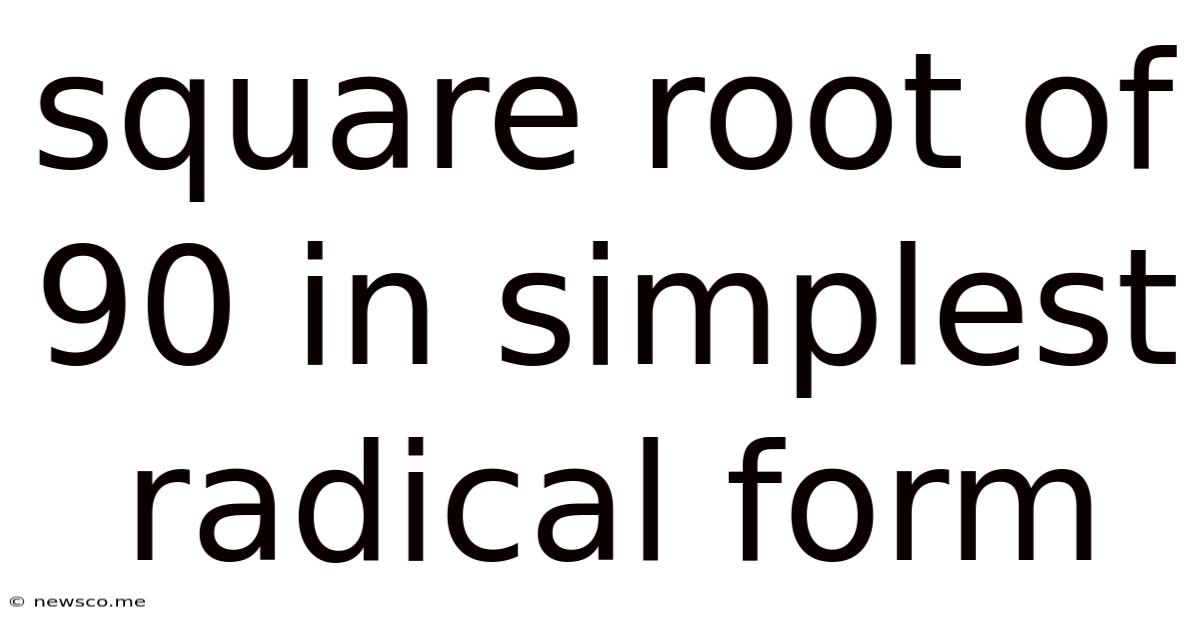Square Root Of 90 In Simplest Radical Form
News Co
Apr 02, 2025 · 5 min read

Table of Contents
Simplifying √90: A Deep Dive into Radical Expressions
The seemingly simple task of finding the simplest radical form of √90 opens a door to a fascinating world of number theory and algebraic manipulation. While a calculator might quickly provide a decimal approximation, understanding the process of simplification allows for a deeper grasp of mathematical concepts and enhances problem-solving skills in more complex scenarios. This comprehensive guide will walk you through the steps, explain the underlying principles, and even explore related concepts to solidify your understanding of simplifying radical expressions.
Understanding Square Roots and Radicals
Before diving into the simplification of √90, let's solidify our understanding of square roots and radicals. A square root of a number x is a value that, when multiplied by itself, equals x. For example, the square root of 9 is 3 because 3 * 3 = 9. We denote the square root using the radical symbol, √.
A radical expression is an expression containing a radical symbol. The number inside the radical symbol is called the radicand. The index of the radical indicates the type of root (square root, cube root, etc.). If no index is written, it's understood to be a square root (index of 2).
Prime Factorization: The Key to Simplification
The key to simplifying radical expressions like √90 lies in prime factorization. Prime factorization is the process of breaking down a number into its prime factors – numbers divisible only by 1 and themselves. Let's find the prime factorization of 90:
- 90 is divisible by 2: 90 = 2 × 45
- 45 is divisible by 3: 45 = 3 × 15
- 15 is divisible by 3: 15 = 3 × 5
- 5 is a prime number.
Therefore, the prime factorization of 90 is 2 × 3 × 3 × 5, or 2 × 3² × 5.
Simplifying √90 Step-by-Step
Now, let's apply the prime factorization to simplify √90:
-
Prime Factorization: As we've established, 90 = 2 × 3² × 5.
-
Rewrite the Radical: Rewrite the square root using the prime factorization: √(2 × 3² × 5).
-
Separate the Factors: Separate the radical into individual factors: √2 × √(3²) × √5.
-
Simplify Perfect Squares: Notice that 3² is a perfect square. The square root of 3² is simply 3.
-
Combine Terms: Combine the simplified terms: 3√(2 × 5).
-
Final Simplification: Multiply the numbers under the radical: 3√10.
Therefore, the simplest radical form of √90 is 3√10.
Understanding the Logic Behind Simplification
The simplification process relies on the property that √(a × b) = √a × √b, where 'a' and 'b' are non-negative numbers. By breaking down the radicand into its prime factors, we identify perfect squares (numbers that have integer square roots), which can then be extracted from the radical. This leaves only the prime factors without perfect square factors under the radical, resulting in the simplest form.
Beyond √90: Practicing with Other Radicals
To solidify your understanding, let's practice simplifying a few more radical expressions:
Example 1: √72
- Prime factorization: 72 = 2³ × 3²
- Rewrite the radical: √(2³ × 3²)
- Separate factors: √(2²) × √2 × √(3²)
- Simplify perfect squares: 2 × 3 × √2
- Final simplification: 6√2
Example 2: √128
- Prime factorization: 128 = 2⁷
- Rewrite the radical: √(2⁷)
- Separate factors: √(2⁶) × √2
- Simplify perfect squares: 2³ × √2
- Final simplification: 8√2
Example 3: √108
- Prime factorization: 108 = 2² × 3³
- Rewrite the radical: √(2² × 3³)
- Separate factors: √(2²) × √(3²) × √3
- Simplify perfect squares: 2 × 3 × √3
- Final simplification: 6√3
Advanced Concepts: Rationalizing the Denominator
In some cases, you might encounter radical expressions with a radical in the denominator. This is generally considered undesirable, and the process of removing the radical from the denominator is called rationalizing the denominator.
For instance, consider the expression 1/√2. To rationalize the denominator, we multiply both the numerator and the denominator by √2:
(1/√2) × (√2/√2) = √2/2
This eliminates the radical from the denominator, resulting in a more manageable expression. Similar techniques are used for more complex expressions.
Real-World Applications of Radical Simplification
While simplifying radicals might seem like a purely theoretical exercise, it has practical applications in various fields:
-
Geometry: Calculating areas, volumes, and lengths often involves square roots. Simplifying radical expressions helps in expressing these measurements precisely.
-
Physics: Many physics formulas, particularly those dealing with motion, energy, and waves, incorporate square roots. Simplifying these expressions is crucial for accurate calculations and interpretations.
-
Engineering: Engineers often use radicals in structural design, electrical calculations, and other applications. Accurate simplification ensures precision and safety.
-
Computer Graphics: Radical expressions are utilized in algorithms for computer graphics and image processing.
Conclusion: Mastering Radical Simplification
Mastering the skill of simplifying radical expressions, like finding the simplest radical form of √90 (which is 3√10), enhances your mathematical proficiency and provides a solid foundation for more advanced mathematical concepts. By understanding prime factorization and the principles of radical manipulation, you'll be equipped to tackle a wider range of mathematical problems with confidence and precision. Remember to practice regularly to further solidify your understanding and improve your problem-solving speed and accuracy. The more you practice, the more intuitive this process will become.
Latest Posts
Related Post
Thank you for visiting our website which covers about Square Root Of 90 In Simplest Radical Form . We hope the information provided has been useful to you. Feel free to contact us if you have any questions or need further assistance. See you next time and don't miss to bookmark.